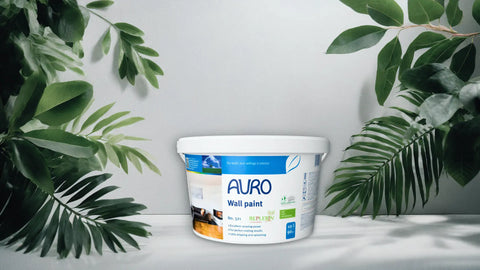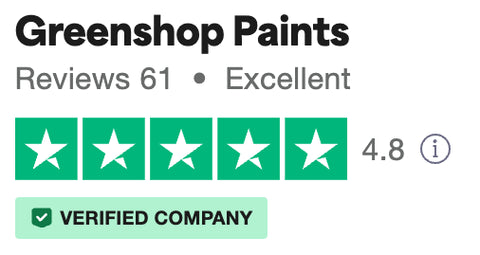Many owners of old houses will understand the frustration of damp walls. Breathable paint can help reverse the issue by allowing walls to naturally release moisture.
This guide will help you understand why damp is a common issue in period properties, and how breathable paints can help dry out your walls!

Pictured: Graphenstone GCS Exterior - Alabaster
Why Damp is Common in Old Homes
Damp walls are a common issue in UK homes. Particularly in old houses with solid stone walls which do not have cavity wall insulation or modern ventilation systems.
Older properties were traditionally constructed with breathable building materials such as lime plaster and render which help moisture evaporate naturally.
Problems With Modern Renovations
Many homes have been renovated in recent decades with cement based plasters, external renders, and plastic based paint.
This can mean the fabric of the building can’t breathe, and moisture is trapped instead of being able to escape. When moisture gets trapped inside a wall, it creates the perfect conditions for mould, flaking paint, and even structural damage.
How Breathable Paint Helps
Unlike plastic based emulsion paints, breathable paints offer a natural solution to allow water vapour to pass through the surface, helping walls to dry out naturally and stay dry over time.
Breathable paints are particularly effective when painting over lime plaster, restoring heritage buildings, or dealing with damp and mould prone spaces like bathrooms, kitchens, and cellars.
What Is Breathable Paint?
Breathable paint is designed to allow water vapour to pass through it, rather than creating a sealed barrier on the wall.
This is particularly important on solid walls or surfaces like lime plaster, which are designed to regulate moisture through absorption and evaporation.
Traditional breathable paints include limewash and clay paint. Modern alternatives include natural mineral and silicate paints. What they all have in common is vapour permeability, and performance rivalling plastic based alternatives.
Understanding SD Values
The breathability of a paint is measured using an "SD value". This tells you how resistant the paint is to water vapour. The lower the SD value, the more breathable the product.
SD Class 1 - Highly Breathable - 0 to 0.14m
SD Class 2 - Moderately Breathable - 0.14 to 0.5m
SD Class 3 - Limited Breathablity - 0.5 to 1.5m
SD Class 4 - Low Breathability - 1.5m+
Any SD value below 0.5 is considered breathable and suitable for most homes. This means the paint has the same resistance to water vapour as 0.5 metres of still air.
SD values are grouped into classes, with Class 1 paints offering the highest breathability, defined as an SD value under 0.14 metres. Always check the technical data sheet (TDS) to verify breathability, as not all "eco" paints are genuinely vapour permeable. Beware of greenwashing!
Types of Breathable Paint for Damp Walls
When tackling damp walls, especially in old houses, there’s many choices when it comes to natural breathable paints. Here's a breakdown of the main types you might wish to consider:-
Lime Based Paints - Highly breathable and ideal for traditional lime plaster and render. Lime paint allows moisture to escape freely, making it a top choice for heritage properties and damp stone walls. It's also naturally mould resistant due to its naturally high pH value.
Clay Paints - Clay paints offer excellent breathability and a velvety matt finish, making them a great option for dry internal walls. They're especially popular for their natural appearance and non-toxic ingredients, though not all clay paints are durable enough for damp or high condensation areas.
Anti Mould Breathable Paints - These combine vapour permeability with natural mould resistance, without relying on synthetic biocides. Ideal for bathrooms, kitchens, and laundry rooms, they help reduce condensation and surface mould by letting moisture escape and through the use of naturally mould resistant ingredients.
Where Breathable Paint Works Best
Breathable paint is ideal for:-
- Cellars and basements – cold walls and poor airflow create a condensation risk.
- Lime plaster and render – traditional surfaces that need to stay breathable.
- Stone walls – solid substrates that need to naturally absorb and release moisture.
- Heritage and period properties – where lime and mineral materials are common.
- Bathrooms and laundry rooms – where condensation forms regularly.
In all these settings, breathable paint helps prevent black mould, bubbling paint, and plaster damage by allowing excess water vapour to escape.
Natural Paints Are Better for Air Quality & Health
Natural breathable paints don’t just tackle damp, they support a healthier home and are eco friendly.
Most are:-
- Free from VOCs or with very low VOC content.
- Made from natural ingredients (lime, clay, minerals, silicates).
- Better for allergy prone households, and respiratory system friendly.
- Environmentally sustainable , with no petrochemicals or plastics.
They help regulate indoor humidity without the need for chemical mould killers. That’s especially useful for bedrooms, living rooms, and nurseries.
Choose Paint That Lets Your Walls Breathe Naturally
If you live in an old house and are dealing with damp, mould, or condensation, using a natural breathable paint can help actively remove trapped moisture and protect the structure of your walls for the long term.
These products support the way traditional walls were meant to perform, by allowing them to breathe.
For best results:-
- Match the paint type to the surface (e.g. lime render, stone, cellar walls).
- Check SD values for real breathability.
- Choose products free from VOCs and synthetic preservatives.
Explore our collection of breathable and anti-mould paints to find the best match for your space.
Please contact us if you need advice about which breathable paints your property might benefit from. Our team is passionate about natural paint, and highly knowledgeable.
Order a free paint colour chart, or buy a reusable paint colour swatch.





